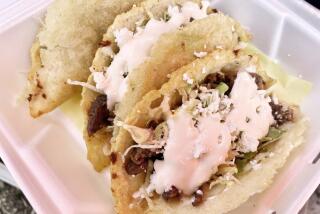The Mango Invasion
- Share via
A decade ago, if you talked about a mango the average guy on the street wouldn’t know whether you were talking about a tropical fruit or the latest dance craze from South America.
But mango mania has hit mainstream America. We have eaten them on vacation--mangoes with sticky rice in Thailand, mango chutney in India, mango daiquiris in the Caribbean. We have read about them in food magazines--trendy chefs have used mangoes with everything from steak to ice cream. And we have seen them at the corner supermarket next to the oranges and lemons. We have become mango savvy.
Mangoes, once a seasonal fruit available from June through September, are now becoming available throughout the year. The U.S. Department of Agriculture recently approved importation of mangoes from a wider variety of countries in Central and South America and the West Indies--if the countries have used a recently approved hot-water-bath treatment to kill insects.
“There is more familiarity today than there was three to four years ago,” says Guillermo Givens, assistant markets editor for the Packer, a trade publication for the produce industry. “People are seeing more and more mangoes in the markets and prices are more favorable. But I think the mango is still one exotic item. A lot of consumers still don’t know what it is. They don’t know whether to cook it or eat it raw. They don’t know when it’s ripe and how to pick a good one.”
In the past, some people who have tried mangoes may not have liked them because they bought a variety that was too fibrous or one that tasted like turpentine. Now both Chiquita and J.R. Brooks of Homestead, Fla., a major U.S. producer of domestic mangoes, are selling varieties without these flaws.
One of the most well-received mango varieties is the Tommy Atkins, a large oblong mango with almost fiber-free flesh. “The true mango aficionado will not judge a ripe mango by its color,” says Bill Schaefer, director of marketing for J.R. Brooks. “They smell the stem end and look for a fruity aroma and know it’s ready to be eaten. But the Tommy Atkins tells you it’s ripe by its color. It goes from red and green to a more vibrant red and yellow.”
America relies mostly on imported mangoes, particularly from Mexico and Haiti. But imports ran into trouble back in the mid-1980s when the U.S. government banned use of the carcinogenic fumigant ethylenedibromide an agent that was used to kill the troublesome fruit-fly larvae that could damage U.S. crops.
Supplies were interrupted briefly until a hot-water-dip treatment was developed. Mexico started using the hot water dip in 1988, but it took until last fall for the Department of Agriculture to allow importation of treated mangoes from Central and South America and the West Indies. The passing of the new rule should mean more mango imports, according to Robert Griffin, head of permits for the Department of Agriculture’s Plant Protection and Quarantine Section.
“Peru, Ecuador and Brazil have now built treatment facilities, but the rest of the countries haven’t yet,” Griffin says. “There is a lot of potential. More mangoes should be available and supplies should increase over the year as facilities are built.”
More to Read
Eat your way across L.A.
Get our weekly Tasting Notes newsletter for reviews, news and more.
You may occasionally receive promotional content from the Los Angeles Times.








